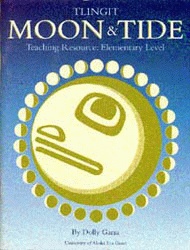People of the Tide
Excerpt from "Tlingit Moon and Tide,"
Chapter 3
Introduction
Humans have been observing the tide for a long time. Ancient mariners thought the tide was caused by the breathing of the earth monster. Tlingit believe the tide was created by Raven to provide food for humans who live along the coast.
 |
| Tlingit Moon and Tide |
 |
The Tlingit people have depended on the ocean and its tides for thousands of years to provide food and a means of transportation. There were many permanent village sites as well as spring and summer campsites on the many islands, sheltered coves, and inlets throughout southeast Alaska. Community members or clans understood the tidal cycle, and clans used this knowledge to move between their winter, summer, and spring sites. Long-term survival of these many villages depended on Tlingit knowledge of the sea and its resources.
Lesson 1: Raven Creates the Tides
Overview
In this lesson, students are exposed to the creation of the tides in the Tlingit world. The creation of the tides is essential to the existence of Tlingit, Haida, and Tsimshian people, who depend on intertidal resources for food, culture, and livelihood.
The full text of this myth can be found in Swanton (1909). "Raven Who Went Down Along the Bull Kelp" has been greatly condensed and simplified; the teacher should read the full myth to understand a part of Tlingit history.
Materials and Equipment
- Copies of Géesh Daax woogoodi Yéil (Raven Who Went Down Along the Bull Kelp)
- Crayons, coloring pencils, etc.
Activity
If possible, have an elder come in and tell the history of the creation of the tides. If this is not possible, read the myth (Raven Who Went Down Along the Bull Kelp) to your students, or have the students take turns reading the myth aloud. You may wish to compare this to the Tsimshian legend, ("Origin of the Tides." )
While students are coloring the "Raven Who Went Down Along the Bull Kelp" handouts, begin asking the following questions:
- What kind of kelp did Raven climb down?
(Nereocystis --- commonly called bull kelp)
- Does this kelp grow around Southeast Alaska waters?
(Yes, in many areas)
- Does it grow around where you live?
(Probably -- teacher should check in her or his area.)
- How does this kelp stay where it is in the water?
(This kelp has a very strong root, or hold-fast, that keeps it attached to the bottom of the ocean.)
- Do you think Raven could climb down the kelp?
(Yes, it is possible -- this is probably the strongest kelp in the ocean and Raven wouldn't pull the kelp off the bottom while climbing down.)
- How low does a tide have to be before you can see the sea urchin when you go out on a beach walk?
(A minus 2.5 or more -- at the lower end of the tide range)
- Do you find sea urchins around bull kelp?
(Yes, they grow all around them and they love to eat bull kelp.)
- Do mink live in Southeast Alaska?
(Yes, they live around most of Alaska, including Southeast.)
- Do mink eat sea urchins?
(Yes -- they eat a variety of seafoods including fish, crabs, sea urchins, clams, and other land foods.)
|
 |
|



